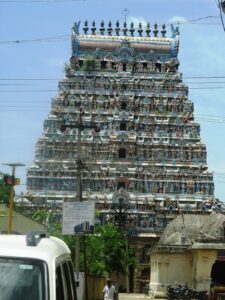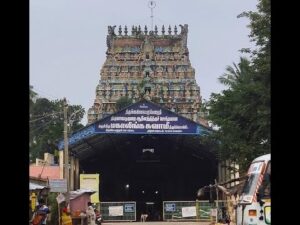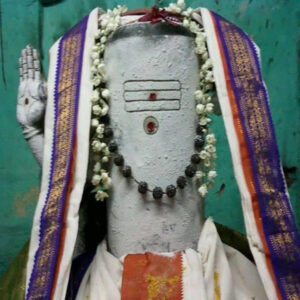Thiruvidaimaruthur Temple:
The Maha Lingeswara Swamy Temple, Thiruvidaimarudur, is a Hindu temple in Thiruvidaimarudur, a village in the Tamil Nadu state of South India, that is devoted to the god Shiva. Being one of the seven principal Shiva temples, Thiruvidaimaruthur Temple holds great significance for the Saivism branch of Hinduism. Shiva is referred to as Jyothirmayalingam, and he is worshipped as Maha Lingeswara Swamy. Shiva is symbolized by the lingam. Devi Bruhatsundarakuchaambika or Bruhatsundarakuchaambigai amman is the representation of his consort Mookambika.
read famous temples in Tamilnadu
The seven consorts of Shiva are said to gather around the temple’s lingam. The Tevaram, a 7th-century Tamil Saiva canonical work composed by poet-saints known as nayanars and categorized as Paadal Petra Sthalam, honors the presiding deity. Manikkavacakar, a poet and Saiva saint from the ninth century, wrote laudatory poems about the temple. Pattinattar, a highly esteemed saint, frequently visited this shrine.
Thiruvidaimaruthur Temple History:
The Thiruvidaimarudur temple site is said to have been used for more than 2,000 years and is connected to the Pandya monarch Varaguna Pandian. Numerous documents of the later Nayaks and Marathas, as well as inscriptions from the Hoysala rulers and some Vijayanagara donations, may be found in the temple. The inscriptions from Kulothunga Chola I on the temple walls describe the revenue survey, settlement, and other internal improvements. A grant of 120 sheep for two lamps is recorded in this inscription (No. 32 of 1895) in the second precinct. The pujaris and locals are designated as the grant’s trustees. It is the 172nd day of the 26th year of Kulothunga I’s reign, during which he subjugated the Kalinga area. The other inscriptions honor the queen as the “mistress of the whole world” and mention her name. Dinachintamani, Elisai Vallabhi, and Tyagavalli were the other three queens.
The devadasi custom, which entails donating dance women to the temple during the medieval era, is another notable historical aspect of the temple. The inscriptions describe the customs, dances, arrangements, and deity procession that take place during festivals. The document dates to the sixth year of Vikrama Chola’s reign (1118–35 CE). In the same style, there are five inscriptions from the tenth century and three later inscriptions with dates of 1123, 1142, and 1218 CE. One probable explanation for the 100-year interval is that Rajaraja I moved all temple women to the Brihadeeswarar temple.
Legend:
It is thought that the name “Kumbakonam,” which roughly translates to “Jug’s Corner” in English, is a reference to the mythical pot (kumbha) that the Hindu god Brahma once held the seed for all living things on Earth. A pralaya, or the collapse of the universe, is thought to have moved the kumbha, which finally came to rest where the town of Kumbakonam currently exists. Around Kumbakonam, there are five shrines: Mahalingeswarar Temple at Tiruvidaimarudur, Tirudharasuram, Naganathar Temple at Tirunageswaram, Tiruvorgam, and Tirupadalavanam. It is thought that these five temples received the nectar drops.
The temple is linked to the story of a Chola prince who killed a Brahmin and was thereafter sought after by his soul, known as the Brahmarakshas. It is thought that the Chola ruler went to the Mahalingeswarar Temple and beseeched his favorite deity, Shiva, for deliverance from the brahmarakshas, or ghosts of the deceased Brahmin. The Chola prince saved himself by leaving through a different door. A few sources link the legend to Varagunapandian, the Pandya king. It still exists today, when worshippers leave the grounds by the second entrance. One of the inner gopurams (tower gateways) on the eastern premises features a sculpture of a Chola brahmaharaksha.
According to legend, Shiva materialized as a flame in order to appease Agastya and the other sages who were carrying out penance. It is stated that Shiva (Rudra) came from Mookambika’s heart. Mahalingaswamy is also thought to have been worshipped by a number of other deities, including Vinayaga, Murugan, Parvathi, Kali, Lakshmi, Saraswathi, Brahma, Airavata (the elephant of the celestial monarch Indra), and Vishnu.
About Temple Tree:
The word Marudur is derived from Maruda, the name of the holy tree. Maruda is the Sthala Vriksha (temple tree). This temple, known as Idai Maruthu, or center Marudur, is categorized as Madhya Arjunam. Thalai Maruthu, or top Marudur, refers to the Mallikarjuna swamy temple in Srisailam, whereas Kadai Maruthu, or lower Marudur, refers to the Thirupudaimaruthur temple at Ambasamudram in the Tirunelveli district. Jyothirmaya Mahalingam is another name for the ruling deity, Shiva, because he manifested himself to the sages as a flame. Shiva was revered in the past as Jyothi, the sacred flame, and Jyothrilinga temples emerged over time. Shiva is also known as Marudavanan since there are so many maruda trees in the area. Arjuna vruksham is the Sanskrit equivalent of the Tamil word maruda.
Thiruvidaimaruthur Temple Timings:
6.00 am – 11.00 am
5.00 pm – 8.00 pm
Pooja rituals started from morning to night
05.30 AM – Ushathkalam
08.00 AM – Kaalasanthi
10.00 AM – Uchikkalam
06.00 PM – Sayarakshai
08.00 PM – IrandamKalam
09.30 PM – Artha Jamam
Thiruvidaimaruthur Temple Address:
Mahalingeswaraswamy Temple, SH 64, Thiruvidaimaruthur, Tamil Nadu 612104
Festivals Celebrated at Thiruvidaimaruthur Temple:
There are monthly celebrations like amavasai (new moon day), kiruthigai, pournami (full moon day), and sathurthi, as well as weekly rituals like somavaram and sukravaram and fortnightly rituals like pradosham. Thaipoosam, the temple’s most popular celebration, is observed for ten days in the Tamil month of Thai. The Mahalingeswarar festival deity and his spouse travel about the village’s streets and temple in various vehicles. On the final day of the festival, Theerthavari takes place. Festivals honoring the sacred marriage of Tirukalyanam, the penance of Ambal Tapasu, and the Ambal Thannai thaane are observed throughout the Tamil month of Vaikasi.
Thiruvidaimaruthur temple official Website – https://www.thiruvidaimarudur.com/
How to reach Mahalingaswamy Temple, Thiruvidaimaruthur:
Nearest airport is trichy which is 113.1 km from the temple. Nearest railway station is Kumbakonam which is 9.5 km from the temple.The shrine is fairly close to the bus station. Good connectivity is provided by both commercial buses and state transportation. In addition to buses, cars, taxis, and private taxis offer good connections.
Thiruvidaimaruthur Temple distance:
Thiruvidaimaruthur temple distance from hyderabad – 16 hr 33 min (891.3 km) via NH40
Kumbakonam to Thiruvidaimaruthur temple – 18 min (9.4 km) via Kumbakonam-Sirkazhi Hwy
thiruvidaimaruthur temple to tamilnadu distance – 2 hr 58 min (141.2 km) via NH 136
thiruvidaimaruthur temple to bangalore distance – 7 hr 51 min (384.5 km) via NH 77
Mayiladuthurai to Thiruvidaimaruthur distance – 40 min (26.4 km) via NH 136B
Thiruvidaimaruthur Temple to Brihadeeswara Temple – 56 min (51.3 km) via NH 136B
Thiruvidaimaruthur Temple to Suriyanar Koil Temple – 13 min (6.3 km) via NH 136B
Thiruvidaimaruthur Temple to Airavatesvara Temple – 25 min (17.6 km) via NH 136B and NH36
Other Temples visit near Thiruvidaimaruthur Temple:
Brihadeeswara Temple
Suriyanar Koil Temple
Kumbakonam Temples
Airavatesvara Temple




